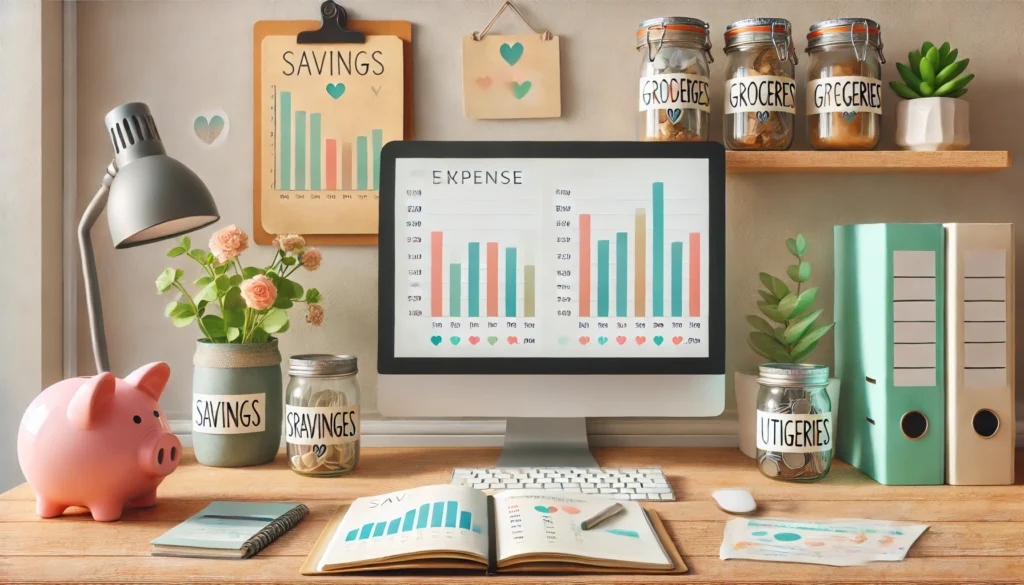Why Tracking Every Dollar Matters More Than You Think
Frugal living isn’t about deprivation or scraping by. It’s about being intentional with every dollar that comes into your household and making it work in the smartest, most efficient way possible. That level of control and clarity doesn’t happen by accident. It begins with something deceptively simple: a spending log. While it may sound like just another tedious financial tool, an expenditure log is in fact the foundation of smart money management. When used correctly, it can transform not only your budget but also your habits, mindset, and long-term financial outlook.
You may also like: 10 Genius Frugal Living Hacks: Effective Ways to Save Money on Household Bills
The act of writing down every purchase – whether digitally or on paper – adds a layer of consciousness that passive bank statements or credit card summaries can’t replicate. It forces you to engage directly with your money, to see it leave in real-time, and to ask yourself whether that transaction was necessary. Unlike broad categories in budgeting apps, a well-maintained spending log shows the nuances: the daily coffee runs, the impulse purchases, the forgotten subscriptions. All those small, seemingly insignificant expenses that accumulate silently in the background are finally laid bare.
Moreover, the psychological impact of tracking every dollar is deeply empowering. For households living paycheck to paycheck, the idea of financial control can feel elusive. But a spending log offers a sense of ownership and awareness that no other tool matches. It reveals patterns, exposes weaknesses, and helps reinforce positive behaviors by showing your progress over time. When your goal is to stretch every dollar, identifying even $50 in waste each month can make a significant difference over the course of a year.
In a world where money often flows digitally, without the tactile experience of cash leaving your hand, the disconnection from spending is real. Logging each transaction bridges that gap. Whether you’re a single-income family, a couple trying to save for a home, or simply someone looking to be more mindful, the expenditure log is not just useful – it’s essential. By the end of this article, you’ll not only understand why every frugal home needs a spending log, but also how to implement one effectively and make it a seamless part of your lifestyle.

What Exactly Is a Spending Log and How Does It Work?
A spending log, also known as an expenditure log, is a chronological record of every financial transaction you make. This includes not only purchases but also bills, fees, subscriptions, and transfers. It’s not meant to be a complex accounting document; rather, it’s a clear and accessible record designed for everyday use. The goal is simplicity and clarity, enabling any household to track their spending patterns without needing a background in finance.
One of the primary differences between a spending log and a traditional budget is that the log captures your behavior in real time. While a budget sets financial intentions, the spending log reveals what actually happens. The two tools work in tandem: one projects, the other reflects. This feedback loop is incredibly powerful, especially for frugal households that rely on continuous course correction to stay on track.
There are numerous ways to maintain a spending log. Some prefer physical notebooks, while others use spreadsheets or mobile apps. What matters most is consistency. Each entry should include the date, description of the expense, category, and amount. Over time, this data becomes a treasure trove of insights. You’ll see not only how much you spend but also where and when your spending spikes. Perhaps weekends are your weak spot, or maybe food delivery is silently draining your monthly savings. These are patterns that no one can fix unless they first recognize them.
Digital expenditure logs, in particular, offer additional layers of functionality. Apps can automatically categorize expenses, send alerts, and generate reports. While these features are useful, they are only as effective as your commitment to reviewing the information they provide. It’s one thing to log a transaction; it’s another to reflect on it, adjust accordingly, and reinforce new habits. The true value of a spending log lies not just in the record itself, but in how you use that record to shape your behavior.
The Psychology Behind Logging Your Spending
Tracking your spending isn’t just a financial exercise—it’s a behavioral one. The human brain is wired to take shortcuts, especially when it comes to money. We rationalize purchases, underestimate cumulative costs, and often avoid confronting our financial habits head-on. A spending log acts as a mirror that reflects those habits back at us, making them impossible to ignore. It disrupts the auto-pilot mode that many of us operate in when it comes to spending.
Behavioral economists have long noted that people tend to experience “pain of paying” more acutely when using cash than when using credit or digital payments. That pain, while uncomfortable, is essential for financial mindfulness. Logging every transaction recreates that moment of reflection. Even if you’re using a debit card or a digital wallet, the act of recording the purchase reintroduces a conscious decision point. It slows down the process, giving you an opportunity to consider whether the expense aligns with your priorities.
Another psychological benefit of a spending log is the shift in mindset from reactive to proactive. When you begin to notice recurring patterns—perhaps a weekly takeout order or impulsive late-night online shopping—you’re better equipped to anticipate and manage those triggers. Rather than reacting with guilt or avoidance, you can set new boundaries or create strategies that support better choices. It becomes a tool not just for accountability, but for emotional self-regulation.
Over time, maintaining a spending log helps develop a sense of financial identity. You move from someone who “tries to save” to someone who “knows exactly where every dollar goes.” That confidence has a ripple effect. It improves communication between partners, enhances goal-setting, and can even reduce financial anxiety. Knowing that you’re in control fosters a sense of security, even if your income hasn’t increased. It’s the clarity and intentionality that changes the game.
Interestingly, the very act of tracking your expenses often leads to reduced spending, even without setting strict goals. This phenomenon, known as the “observer effect,” suggests that when we pay attention to our behavior, we naturally begin to self-correct. Just knowing that you’ll need to write something down can be enough to dissuade unnecessary spending. It turns your awareness into a built-in accountability system, which is one of the most powerful tools for anyone practicing frugal living.

Frequently Asked Questions (FAQ)
1. How can an expenditure log help improve financial habits?
An expenditure log serves as a powerful tool for developing disciplined financial habits by offering a clear, detailed record of every dollar spent. By consistently maintaining a spending log, individuals can identify unconscious spending patterns and recognize areas where they might be overspending. This level of awareness fosters mindful financial decision-making, helping people allocate their resources more effectively. Moreover, the practice of logging expenses can create a psychological barrier against impulse purchases, as individuals become more accountable for their transactions. Over time, reviewing an expenditure log can reveal significant insights into financial trends, allowing for more informed budget adjustments and long-term savings strategies.
2. What are the psychological benefits of maintaining a spending log?
Keeping a spending log does more than just track financial data; it also fosters a sense of control and reduces financial anxiety. Many people experience stress due to uncertainty about where their money goes, and an expenditure log eliminates this ambiguity by providing concrete details. Additionally, regularly updating a spending log can serve as a form of self-reflection, encouraging users to align their purchases with their values and long-term goals. The act of documenting expenses reinforces positive spending behaviors and discourages wasteful habits, promoting a healthier relationship with money. Ultimately, this practice builds financial confidence and encourages a proactive approach to managing personal finances.
3. How can businesses leverage expenditure logs for better financial management?
Businesses, regardless of size, benefit greatly from an expenditure log by gaining detailed insights into operational costs and cash flow patterns. A well-maintained spending log allows companies to pinpoint inefficiencies, eliminate redundant expenses, and optimize their budgets for maximum profitability. Additionally, expenditure logs facilitate better forecasting, as past spending trends help predict future financial needs more accurately. By integrating digital tracking tools, businesses can automate expenditure logs, ensuring accuracy and reducing the likelihood of financial discrepancies. Moreover, maintaining a comprehensive spending log enhances transparency and accountability, which is especially crucial for businesses with multiple stakeholders or employees handling company finances.
4. How does a spending log help with setting realistic financial goals?
A spending log provides the concrete data necessary to establish realistic and attainable financial goals by showcasing actual spending habits over time. Without a detailed expenditure log, financial planning often relies on estimates, which can lead to unrealistic budgeting and eventual frustration. By reviewing a spending log, individuals can distinguish between essential and non-essential expenses, making it easier to set priorities and allocate funds accordingly. Furthermore, seeing tangible proof of spending patterns helps people make informed decisions about adjusting their financial goals, whether it’s saving for a major purchase or reducing debt. A well-maintained expenditure log serves as an ongoing financial roadmap, keeping individuals accountable to their aspirations.
5. What are the most effective ways to maintain a spending log without feeling overwhelmed?
Consistency is key when maintaining an expenditure log, but many people struggle with staying committed to daily logging. To avoid feeling overwhelmed, using digital apps that automate spending logs can simplify the process and ensure accuracy. Additionally, categorizing expenses—such as food, transportation, entertainment, and savings—makes reviewing financial habits easier and more efficient. Setting aside a specific time each day or week to update the spending log helps integrate the practice into a routine without becoming a burden. Lastly, focusing on the benefits of maintaining an expenditure log, such as increased savings and reduced financial stress, can serve as motivation to continue the habit over time.
6. How can a spending log help detect financial leaks?
A spending log is an essential tool for identifying small, recurring expenses that can accumulate into significant financial drains. Many people are unaware of how much they spend on subscriptions, dining out, or impulse purchases until they analyze their expenditure log in detail. By reviewing past spending logs, individuals can pinpoint unnecessary costs and make adjustments accordingly. For instance, someone might realize they are paying for multiple streaming services they rarely use, prompting them to cancel or consolidate subscriptions. Identifying these financial leaks through a spending log can lead to more efficient budgeting and greater financial stability.
7. How can technology enhance the effectiveness of an expenditure log?
Modern financial tools and apps have revolutionized the way people maintain an expenditure log, making the process more convenient and insightful. Many digital spending logs integrate with bank accounts and credit cards, automatically categorizing transactions to reduce manual input. Advanced features, such as real-time spending alerts and AI-driven financial insights, help users make smarter financial decisions. Additionally, cloud-based expenditure logs enable users to track their expenses across multiple devices, ensuring accessibility and ease of use. By leveraging technology, individuals and businesses can maximize the efficiency of their spending logs while minimizing the effort required to maintain them.
8. How does an expenditure log contribute to long-term financial stability?
An expenditure log provides a historical record of financial behavior, making it an invaluable tool for long-term financial planning. By analyzing patterns in a spending log over months or years, individuals can anticipate seasonal expenses, adjust budgets proactively, and create emergency funds. Moreover, having a well-documented expenditure log is essential for major financial decisions, such as purchasing a home, starting a business, or planning for retirement. It also fosters financial discipline, ensuring that individuals make informed choices rather than acting on impulse. Over time, the habit of tracking expenses through a spending log leads to improved financial health and a stronger sense of financial security.
9. How can couples use a spending log to improve financial communication?
For couples, maintaining a shared expenditure log can be a game-changer in fostering financial transparency and cooperation. A spending log allows both partners to see where money is going, reducing the likelihood of misunderstandings about financial priorities. It also encourages open discussions about budgeting, spending habits, and financial goals, helping couples align their financial strategies. Moreover, tracking expenses together can strengthen financial accountability, ensuring that both partners contribute fairly to shared financial responsibilities. By using a spending log as a collaborative tool, couples can prevent financial conflicts and work towards their financial aspirations as a team.
10. What are some common mistakes people make when keeping a spending log?
One of the biggest mistakes people make when maintaining an expenditure log is failing to record small purchases, which can add up significantly over time. Another common error is neglecting to review and analyze the data, as simply logging expenses without drawing insights from them defeats the purpose. Additionally, inconsistent tracking can lead to incomplete or inaccurate spending logs, reducing their effectiveness in financial planning. Some individuals also forget to categorize their expenses properly, making it harder to distinguish between necessary and discretionary spending. To maximize the benefits of an expenditure log, it’s important to maintain consistency, review spending patterns regularly, and use the insights gained to make informed financial decisions.

Conclusion: A Small Habit That Unlocks Big Financial Wins
Embracing a spending log as part of your daily routine may seem like a modest step, but its impact on your financial life is profound. For frugal households striving to stretch every dollar, this tool is more than a simple record—it is a catalyst for change. An expenditure log brings visibility to your spending habits in a way that no budget spreadsheet or monthly statement can. It doesn’t just show you where your money went—it teaches you how to make better choices moving forward.
Over time, the insights you gain from consistent logging become invaluable. You’ll start identifying spending leaks you didn’t even realize existed and redirecting that money toward savings, debt repayment, or investment goals. You’ll also develop a heightened sense of financial discipline, confidence, and control. And perhaps most importantly, a spending log encourages long-term thinking. Instead of reacting to financial problems after they arise, you begin preventing them before they take root.
In a culture that often encourages mindless consumption, a spending log is a quiet act of rebellion. It empowers you to be intentional, to live within your means, and to prioritize what truly matters. Whether you’re managing a tight budget, working toward financial independence, or simply seeking peace of mind, tracking every dollar spent is one of the most effective habits you can adopt. It’s simple. It’s sustainable. And for the frugal household, it’s non-negotiable.
Start today. Don’t wait for the next paycheck or a new app. Grab a notebook, open a spreadsheet, or download a simple tracker. Begin logging, stay consistent, and watch how this small habit yields massive financial clarity. Because once you start using a spending log regularly, you’ll wonder how you ever managed your money without it.
personal finance tracking, mindful money habits, financial awareness tools, budget organization methods, household finance management, save money strategies, cash flow insights, daily money tracker, frugal family planning, practical budgeting ideas, financial control techniques, low-income budgeting help, zero-based budgeting tips, money-saving habits, personal money management, expense tracker tools, family budget tools, money mindfulness practices, daily expense monitoring, financial planning for frugal living
Further Reading:
Here is why You need to Record your Daily Expenses
Detailed tracking expenses and spending. Is there real value?
Frugal Things Every Day: Daily Habits for Saving Money
Legal Disclaimer
The information provided in this article is for general informational purposes only and is not intended to constitute financial, investment, legal, tax, or other professional advice. The content should not be relied upon for making any financial or investment decisions. Readers are encouraged to consult with licensed professionals, such as financial advisors, attorneys, or tax experts, to obtain personalized advice tailored to their individual circumstances. The author and publisher disclaim any liability for any actions taken or not taken based on the information provided in this article.





